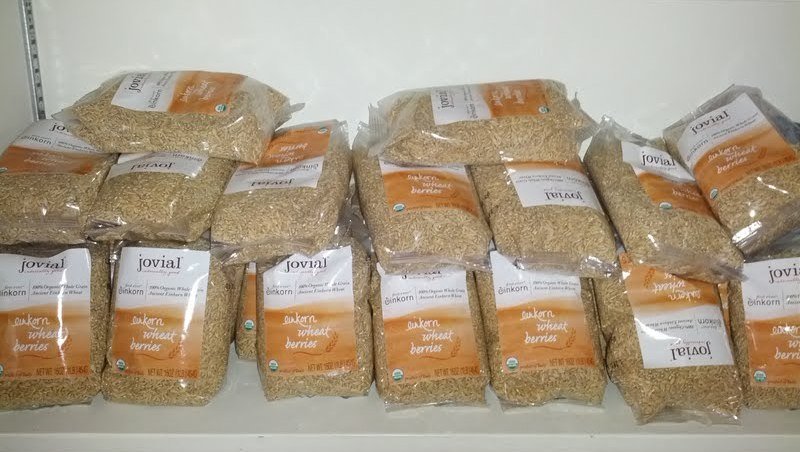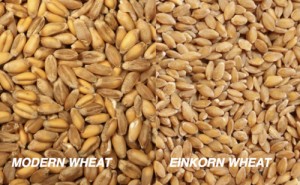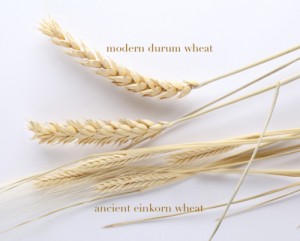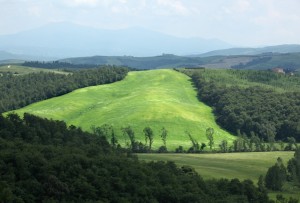Einkorn is the only form of wheat on Earth that is completely unhybridized, containing the good gluten that even sensitive individuals can usually eat. Consuming it has four main benefits.
In my home, I’ve purchased organic white wheat and spelt in bulk for many years. Grinding it into fresh flour is the most nutritious and tastiest way to bake! I also did this to avoid the conventional toxic wheat in North America.
Farmers on this continent frequently desiccate their crops with glyphosate-containing herbicides. This practice is beneficial for ease and speed of harvest.
I credit this approach with my family avoiding any wheat allergies or problems digesting grains in general. This is true provided they are traditionally prepared. Bulgur is an example of this ancestral practice still widely used today.
For those of you who do have wheat issues, you’ll be encouraged to know that my husband used to have allergy and digestive issues with wheat years ago. He no longer does thanks to careful avoidance of wheat for several years, rebalancing the gut with traditional cooking, raw dairy, and the GAPS Diet.
Having a lot of experience dealing with wheat allergies, I can say that there certainly is a huge difference between modern processed wheat, products made with it such as seitan, and what you produce yourself at home.
I remember when I was breastfeeding my youngest child, if I ate so much as a mouthful or two of processed wheat at a restaurant in the form of a sandwich, slice of pizza, or a bread roll, she would spit up for one or sometimes even two days!
If I ate wheat that I ground myself and either sprouted, soaked, or sour leavened, however, she never had any spit up issues. To me, this was a huge testament to the radically improved digestibility of wheat that is prepared using the wise methods of ancestral cultures.
Einkorn Health Benefits over Modern Wheat
Given my success over the years with incorporating traditional methods of wheat preparation in my home, you may be surprised to learn that I’m switching the type I use.
What’s more, I’m switching 100%.
I still have about half of a large bucket of organic spelt to use up and a small amount of organic soft white wheat before the switch is complete. My goal is to have my family completely transitioned to einkorn wheat within another month or two.
Here are the 4 reasons why I am making the wholesale change to einkorn. Note that this strain is not to be confused with farro or heirloom wheat:
#1: Better Taste
My first experience baking with einkorn occurred after I received a thoughtful gift of, among other things, einkorn flour and wheat berries. I was delighted when I ground the einkorn into flour and saw how light and white it was.
I am not a fan of bran and am not of the food philosophy that all that fiber is actually good for you. Folks just think they need a lot of fiber as they are so constipated from all the processed foods they eat! Observing that einkorn, the most ancient and unhybridized form of wheat, has less bran compared with modern wheat was encouraging to me.
I was thrilled to see that my family thoroughly enjoyed the soaked waffles made with fresh einkorn flour. It was my first einkorn dish! Ever since they have asked me to use only that flour.
Like any Mom, I’m a sucker for kids who love my cooking and tell me so on a frequent basis. So, I made the easy decision to switch to einkorn completely for all my home baking.
#2: More Digestible
My husband’s stomach is my canary in the coal mine. If something is not easy to digest, he can tell and lets me know right away. As he has fully recovered from a wheat allergy, he knows which forms of wheat and which preparation methods sit best in his stomach and which do not.
While my properly prepared grain dishes made with wheat or spelt digest fine for him, once he tried the einkorn, he could tell that his digestion was even lighter for the experience. This is possibly because einkorn contains good gluten, different on a molecular level from modern gluten. It is much better tolerated by those with gluten sensitivity.
Better digestion means better absorption of nutrients, so einkorn surpassed the competition in that category.
#3: Einkorn is Visually Different

The first thing I noticed when I ground einkorn into flour for the first time was how much smaller a grain of einkorn is compared with a grain of modern wheat. They are about half the size!
In addition, the telltale crease on one side of a grain of modern wheat is absent from a grain of einkorn. The reason for the differences is that over the centuries, the genetics of wheat gradually changed due to human cultivation practices.
Year after year, farmers selected the seeds at harvest time that suited the goal of higher yields and more gluten. This worked best for big farms and larger-scale agriculture, production, and distribution of wheat products.
#4: Only Unhybridized Wheat on Earth

Einkorn is like most plants in that it is diploid. This means that contains only 2 sets of chromosomes. About 2,000 years after einkorn wheat, nature created emmer via the hybridization of 2 wild grasses. Consequently, emmer has 4 sets of chromosomes. Kamut and durum (bulgur) wheat are both descendants of emmer.
Spelt, an heirloom wheat, is the result of hybridization between cultivated emmer and another wild grass. Thus, it contains six sets of chromosomes. Modern wheat is a descendant of spelt.
Note that while humans extensively hybridized wheat over the millennia, there is currently no genetically modified wheat on the market. In the Western United States, however, test plots of GMO wheat have caused some contamination issues.
As you can see, einkorn is the purest and most ancient form of wheat available. It has only 2 sets of chromosomes with a very different composition of gluten. This form is easier to digest for many with non-genetic gluten intolerance.
Where to Source the Best Quality Einkorn
The only downside of einkorn is that it is not widely available and tends to be more expensive than other types of wheat. It is still quite new to the North American market.
My healthy shopping guide lists sources that I’ve vetted that are fast and affordable to ship to your door. I use these reliable companies myself and have for many years.

The organic einkorn wheat berries from these sources are grown and packaged on one secluded and pristine farm in Tuscany. It is very important to rotate crops on this farm. This is due to the hilly terrain, where yields are low and the land must stay fertile.
What this means is that this particular source of organic einkorn comes from fully pastured fields for five years prior. In addition, soil nutrition is enhanced using one year of crop rotation with the cultivation of chickpeas, lentils or fava beans. This ensures that there is no risk of cross-contamination with other types of grains. Each year’s crop of einkorn comes from truly fertile earth!
Have you tried einkorn wheat yet? If so, what observations have you made about this ancient, unhybridized wheat?
More Information
Sourdough Crackers with Nut Butter
No-Knead Sourdough Bread
Teff Nutrition








Made my first batch of einkorn bread today.
Can it be used like regular wheat?
How do you grind your own wheat at home? Will a vitamix work?
Yes, you need the dry container for Vitamix, but it works perfectly.
Wheat grinded with non-stone mill loses all the benefits because during the grinding process the benefits of stone grain mill are that it keeps the grain in low temperature and avoiding overheat over 60 degrees C will keep all the nutrients, vitamins, iron, enzimes etc. Buy a stone electric grain mill.
depends on the speed the mill runs at. I have a good sized steel burr mill that I run at moderate speed (10HP 3 phase motor on it) the meal/flour coming out is warm but not hot. It gets much hotter when cooked. A small hand cranked burr mill for home use is much slower than mine and heats very little. Commercially flour is ground with a hammer mill because of the volume they can put out. Completely different action.
While we are on grain subject, any one have opinions or tips on barley? (I know it is not gluten free, but other thoughts?). I have had a hard time cooking it, but I cannot even make rice. However I started making my own bread and want to start making my own flour soon
The Healthy Home Economist what about Organic Emmer? Is that ok? Or Triticale? I’m trying to learn 😉 Thanks!
i wish! but now im not eating any grains at all :p
I have read that the reason there is no GMO wheat is that farmers want Roundup to kill the wheat to make it easier to harvest, and they spray it with Roundup a few days before harvest. A good reason to go organic if that is true.
I can’t speak for all wheat farmers but I dated a wheat farmer for awhile (through a harvest) and they certainly didn’t spray anything on their crop to kill it. They wouldn’t have dreamed of it! They used chemical fertilizer and maybe some herbicides if weeds were bad in a particular area, but usually not even then because they didn’t want to waste the money. They also bug bombed it in the silos {shudder} but I never did heard of anyone using round up to kill it before harvest. They were a pretty big family farm and so were their friends but maybe big corporations are different.
I DO NOT eat wheat period!! Need to read Wheat Belly, author William Davishttp://youtu.be/UbBURnqYVzw
I felt that way too until I travelled through Europe for 5 weeks. I hadn’t touched bread in 7 years! I ate bread every day in Greece that was made by hand and noticed I had no problem with it. That’s when I started looking into these ancient grains. Since switching to Einkorn, we are loving our bread again. Bread is not bad, but American wheat should be avoided at all costs. This is an ancient form of wheat grown without contamination in Italy and other parts of Europe. It’s not new.
I get organic sprouted flours like einkorn from healthyflour.com from Fitzpatrick, AL in the USA and have for over 10 years now. I grind it in my vita mix blender with a special grain container. In our country we have good food here too. More and more natural organic foods all the time.
Any links on how to prepare, grind it? What about soaking and the waffle bread recipes? Is it easy to digest even for someone with seasonal allergies. Thanks 🙂
I’m made bread and it was really good.